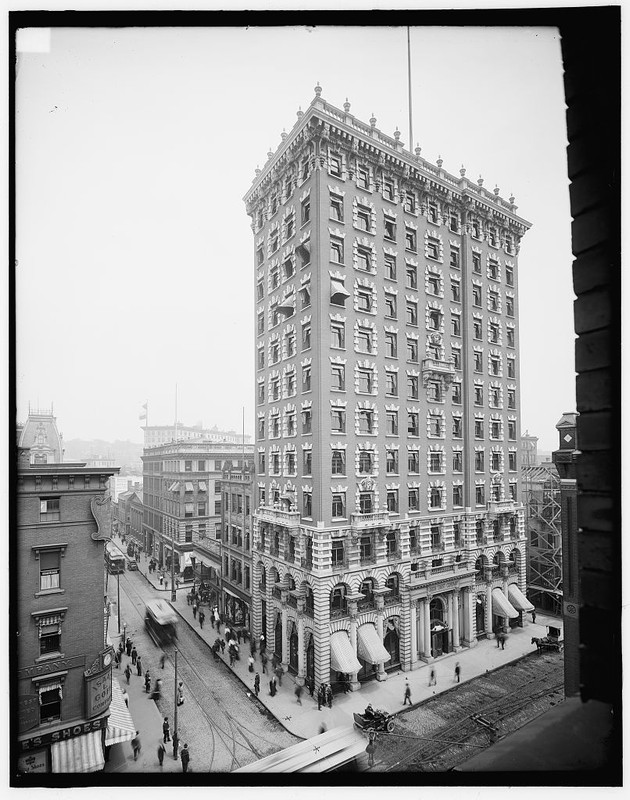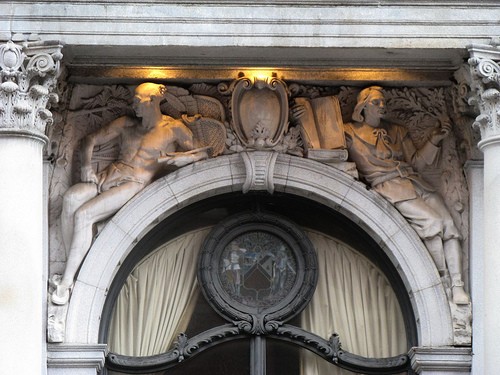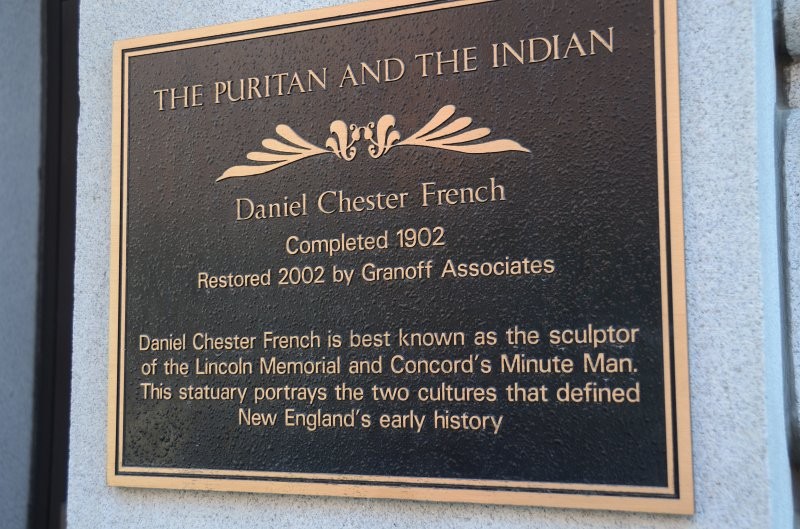Union Trust Company Building
Introduction
Text-to-speech Audio
Designed by the local architectural firm of Stone, Carpenter and Wilson, the Union Trust Building - a twelve-story steel-framed structure, externally faced in brick and stone - was constructed by the Union Trust Bank, headed by prominent financier Marsden J. Perry, in 1901-1902. It is in the Renaissance Revival style and was among the tallest buildings in New England at the time it was completed. A banking publication of 1904 wrote of the building: “Rising to a height of 12 stories, it stands a graceful monument of prosperity based upon sound financial methods.” It is currently owned by Providence Capital LLC; the Dorrance Restaurant is on the first floor, where the bank's offices once stood. It was placed on the National Register of Historic Places in 1973.
Images
The Union Trust Building as it appeared in approximately 1906.

Daniel Chester French's sculpture, The Pilgrim and the Indian.

Plaque commemorating Daniel Chester French's sculpture, The Pilgrim and the Indian.

The Union Trust Building as it appears today.

Backstory and Context
Text-to-speech Audio
The Union Trust Bank was led by legendary Providence-based
financier and industrialist Marsden Jasael Perry, who had joined the institution
in 1881 and became its president in 1901. Perry was referred to at the time as “the man who owned
Rhode Island,” though he had been born a poor farm boy. Among the institutions Perry owned were the Narragansett Electric Company and the city's trolley system. (Perry also bought Providence's historic John Brown House
in the city in the same year.) After Perry took charge, the bank decided that it needed to construct its own building in the downtown area. The first and second floors of the Union Trust Building were reserved for the bank’s
use; other floors were rented as office space. The building was originally nine bays wide and four bays deep, but was expanded to seven bays deep when renovated in 1920.
Union Trust Company was absorbed by the Industrial National Bank in 1957, which sold the building. It was acquired by Greater Providence Deposit and Trust company in 1980, which used it as a headquarters until 1991, when the company was forced to close due to the banking crisis. In 2007, the building was sold for 6.7 million and on March 5th, 2015, its current owner, Providence Capital LLC, purchased the building for $4.4 million. It plans to convert all but the first two floors into apartments within the next five years; the second floor will be renovated as commercial space and the Dorrance Restaurant will remain on the first floor.
The first and second stories are of rusticated granite. The third floor has its own distinct rustication, while the fourth through twelfth floors are covered by brick and trimmed with white Georgia marble. The first floor has banks of 20-foot-high windows, each topped by a stained-glass rosette displaying the coat of arms of a major European bank family or banking center. The west front entrance of the building has an elaborate stone portico; the columnns of this portico support a massive entablature and above this entablature is a balustrade with urns. Over the entrance is an unusual feature: a bas-relief sculpture by the distinguished sculptor Daniel Chester French (the designer of the Lincoln Memorial), showing reclining figures representing "The Puritan and the Indian." The interior has two distinctive features: a 12-story staircase made of green glass (elevators could not be built to accommodate such a tall building in those days) and the first double-doored bank vault in New England. These doors kept Union Trust’s currency dry during the great flood of 1938.
Union Trust Company was absorbed by the Industrial National Bank in 1957, which sold the building. It was acquired by Greater Providence Deposit and Trust company in 1980, which used it as a headquarters until 1991, when the company was forced to close due to the banking crisis. In 2007, the building was sold for 6.7 million and on March 5th, 2015, its current owner, Providence Capital LLC, purchased the building for $4.4 million. It plans to convert all but the first two floors into apartments within the next five years; the second floor will be renovated as commercial space and the Dorrance Restaurant will remain on the first floor.
The first and second stories are of rusticated granite. The third floor has its own distinct rustication, while the fourth through twelfth floors are covered by brick and trimmed with white Georgia marble. The first floor has banks of 20-foot-high windows, each topped by a stained-glass rosette displaying the coat of arms of a major European bank family or banking center. The west front entrance of the building has an elaborate stone portico; the columnns of this portico support a massive entablature and above this entablature is a balustrade with urns. Over the entrance is an unusual feature: a bas-relief sculpture by the distinguished sculptor Daniel Chester French (the designer of the Lincoln Memorial), showing reclining figures representing "The Puritan and the Indian." The interior has two distinctive features: a 12-story staircase made of green glass (elevators could not be built to accommodate such a tall building in those days) and the first double-doored bank vault in New England. These doors kept Union Trust’s currency dry during the great flood of 1938.
Cite This Entry
Baldwin, John. "Union Trust Company Building." Clio: Your Guide to History. February 8, 2016. Accessed August 11, 2025. https://theclio.com/entry/21541
Sources
http://www.preservation.ri.gov/pdfs_zips_downloads/national_pdfs/providence/prov_dorrance-street-62_union-trust-company-building.pdf
http://pbn.com/Union-Trust-Co-building-to-be-converted-to-apartments,105217
http://choosing-providence.blogspot.com/2013/08/marsden-perrys-skyscraper-union-trust.html
http://www.ricurrency.com/bank-name/union-trust-company-providence
bit.ly/1Q2gXAj

